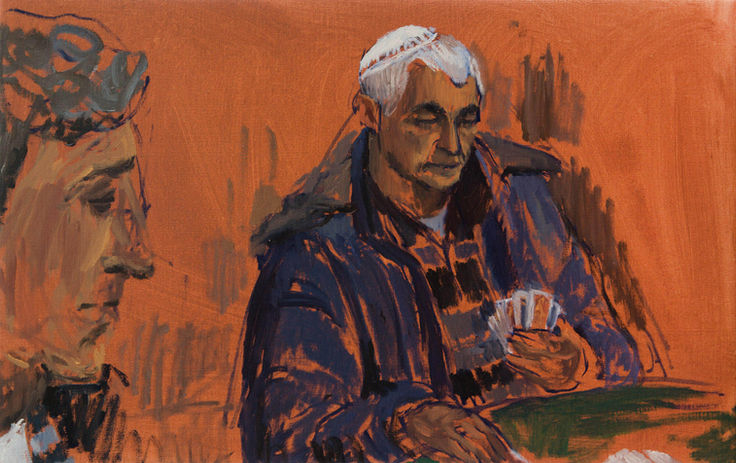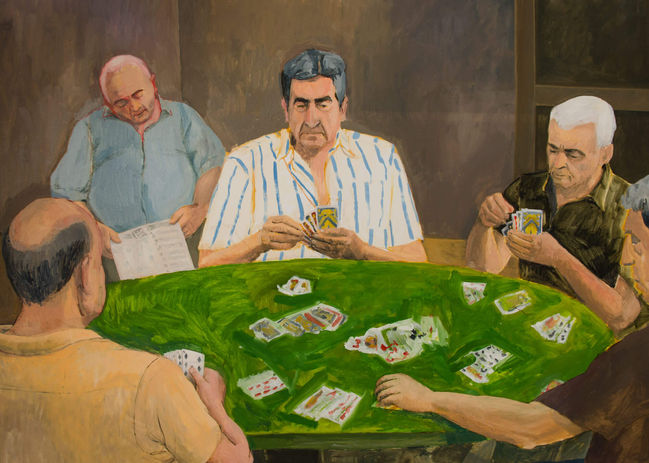The Card Players
Artist:
29.2.20
Main Gallery
Curator: Tal Yerushalmi
Click image to view Catalog
The Card Players / Uta Patinkin
Interviewer: Tal Yerushalmi
How did you come to paint the group of card players?
When we returned to Israel, I began to teach painting, and among the places in which I taught was a pensioners' club in Jerusalem. A group of card players sat in the room next door to the painting classroom, and I always glimpsed at them, toying with the idea that one day I would endeavor to paint them.
I had some reservations about this pictorial subject. First, it is one which has been dealt with extensively by numerous artists throughout the history of art—especially, of course, by Cezanne in his series The Card Players, which is impossible not to address in some way or another while approaching this subject. What does my version convey vis-à-vis his? I was not so sure I wanted to be in this position: why do I need the burden of Cezanne on my shoulders?
The additional reservation I had was that I did not know in which way I would paint. For the most part, the manner in which I paint is facing a model in the studio. I invite a model to sit for a number of hours in the course of several meetings; I design the set-up, the space, accessories, furniture and textiles, thereby creating a staged, fixed setting I wish to paint. Face-to-face with the card players, an entirely different way of working was required.
Ultimately, the very qualms hesitation I had had at the start were what captivated and intrigued me to try and tackle the subject.
Can you tell us about your work process?
For over a year, I set out to paint the card players in Jerusalem about once a week. The players tend to switch seats from meeting to meeting, and sometimes the composition of the participants changes, so the setting is transitory. Every time I went, I painted a small painting in color, which I began and completed on that same day, from direct observation of the group.
Working with the card players signaled a new way of painting for me. Because they are immersed in the game, they move only slightly and return to their original position, so I could work with "models" from life itself without having to request that they sit for me in a staged setting. I entered their world as an observer from the side, without interrupting.
This kind of work fascinated me. I did not know where it would lead, but I thought I'd paint several paintings and then see if I could develop them further. I was drawn to the vitality of working with individuals in their natural setting. The quick paintings imbued my work with a lot of new energy which remained with me in the studio, too. Bit by bit, I began to accumulate small paintings of the card players from all of my visits, so I began thinking of ways in which I could develop the subject into a continuous work as opposed to short paintings. I realized I had plenty of raw material to work with. I studied the paintings I had painted and the photographs I had taken of the card players, and I started to draw new compositions. In parallel with my Jerusalem visits, I started working on large paintings in my studio.
What would you say is the difference between the paintings painted from direct observation in situ and those painted in the studio?
Every manner of working required something different of me. The paintings painted "in the field" in a short period of time necessitated swift perception and quick action. This kind of work requires that the painter act intuitively, and there is less room for deliberation or criticism. There is something truly stirring in it because it is work with a high level of adrenaline. I paint on the scene itself and not in the laboratory conditions of my studio. The greatest advantage of this manner of working is that it is completely unpredictable; I arrive at a short-lived painting encounter without knowing what it will engender, and this creates pictorial events that are altogether new to me. It is painting with neither formats nor habits, and hence it freshens my painting practice as a whole. The work in the studio is utterly different. Even though the spontaneity and the unfettered brush strokes which characterized my work on the small paintings did permeate my studio work, as well, the latter necessitates cogitation, planning and much commitment. The individual painting does not remain in its initial, unripe, fresh form but rather undergoes a process in which my intentions and the expressiveness are made more precise. Studio work entails an attempt to rectify the relationships between forms and color so that these may manifest the human event depicted.
In your painting, there are parts which are complete or "done" to varying degrees. What is the difference between these parts?
Part of my endeavor in undertaking the subject of the card players was to place myself before a challenge I did not know I could meet. This was an attempt to lead myself to unforeseeable places. The subject is a complex pictorial challenge because it includes multiple figures and a human interaction which creates complexity with respect to placement and composition. It appealed to me to do something which I could not bring to the level of completeness I ordinarily strive for in my paintings, and I kept extending the challenge and enlarging the size of the canvas. I learned to reconcile myself to the incompleteness and discovered that these works derive their force and beauty from the rawness of the painterly gesture within them. The helplessness and inability brought newness to the painting, novel possibilities that sprang from a state of relinquished control. This was risky business for me, like a game of betting.
What is the relation between your painting and the subject of the card players, a prevalent subject in the paintings of artists in different periods?
At first, I preferred not to look at paintings of card players by other artists in an attempt to discern what emerged from my own work, without involving external influences.
Of course, I had been familiar with quite a few paintings of card players, but I did not actively look for them at this stage. It is only when I had a considerably large body of work and when my relation to the subject became clearer to me that I began to research, read articles and examine paintings. I set about gathering images of card players from different periods, from the Renaissance onwards. This was a very common subject, particularly in the 18th century, when artists began painting simple scenes of daily life. Some paintings depicted the card game in shabby bars and presented it as a forbidden activity carried out behind closed doors and associated with alcohol, prostitution and betting. Other paintings presented card players in the context of high society entertainment.
I contemplated the well-known paintings of card players such as those of Caravaggio, Chardin Cezanne and Balthus. They were very meaningful to me.
Balthus and Caravaggio present through the card game the less "comely" human facets—the struggle, deceit and concealment.
With Cezanne, I think, the card players express the stance of a human being vis-à-vis the player facing him, not only in a direct way but in a more profound, human sense: the players look at the cards they are holding and not at each other. It is not a situation depicting demonstrative acts between individuals but rather one of introspection, an inner motion, and this is something that resonated with me.
And what interests you in the subject itself?
The subject of the card players appeals to me for several reasons: first, it is an engrossing human interaction in a world in which human interactions are diminishing in an era of technology and screens. Through the activity of the game –bodily gestures without many words—a communicative encounter between individuals is set in motion, an entire world of relations is born. The card game is also a symbolic world which contains secrets and concealment as the game is carried out surreptitiously. Every player keeps his cards to himself while remaining cautious and suspicious of the other players.
I see in the card game an allegory for the human being's bearing in the world.
The individual facing the world-group from his particular standpoint: who is he, and how does he perform in the game? Which cards does he keep to himself, and which does he jettison? A person stands in the world and holds his cards close to his heart. He chooses what to reveal and how to act—
chooses his steps.
The game is not just a simple, convivial one, as two players might pass a ball to each other. The element of money is highly significant and adds tension and weight to every move. Every person is responsible for himself and fights for his place in the world; the card game lays bare a world of human phenomena in which every individual expresses his condition.
Was a relationship formed between you and the painted players?
Naturally! First, they already knew me beforehand as the painting teacher at the club. With time, after I had asked for their permission to paint them and as I began to work, friendly relations were formed, and they were happy whenever I arrived. We chatted from time to time, and once they even tried to teach me the rules of the game. My presence did not bother them, and they behaved naturally and enjoyed the attention and the element of surprise in seeing themselves appear in my paintings at the end of every session. I remember a day when I arrived at the club, and they had not been playing for lack of participants. Someone immediately exhorted: "come on, guys, the painter is here, let's play so she can paint!"
UTA PATINKIN
utapatinkin@gmail.com
www.utapatinkin.com
Born in Israel, 1987. Live in Tzafririm Village, work in Tel Aviv Israel
Education:
2009-13 Certificate, MFA in Painting, New York Studio School of Drawing, Painting and Sculpture, New York, NY.
2006-08 Tel Aviv Museum of Art Education Center, Tel Aviv, Israel.
SOLO EXHIBITIONS:
2020 “The Card Players” Maya Gallery, Curator: Tal Yerushalmi, Tel Aviv, Israel.
2020 “Paintings”, Rothschild Fine Art Gallery, Tel Aviv, Israel.
2017 “The Birdcage and other paintings”, Liza Gershuni Gallery, Curator: Ron Bartos, Tel Aviv, Israel.
2013 Two-Person show, Avner Levinson & Uta Patinkin, alternative art space, Brooklyn, NY.
2013 Two-Person show, New York Studio School, New York, NY.
2012 Graduation Certificate Exhibition, New York Studio School, New York, NY.
2011 New York Studio School, New York, NY
SELECTED GROUP EXHIBITIONS:
2019 “Connections”, Gerald Moore Gallery, London.
2018 "Chain Reaction" The Painting Center Gallery, Chelsea, New York, NY.
2017 Annual juried exhibition, Bowery Gallery, Juror Kyle Staver, Chelsea, New York, NY.
2016 “Fresh Paint 8” Contemporary Art Fair, Independent Artists Greenhouse, Tel Aviv, Israel.
2015 "Salon HaKubiya", Manofim Art Festival, Jerusalem , Israel.
2015 “New Faces”, Artspace TLV Gallery, Curator: Zvi Lachman, Tel Aviv, Israel.
2015 ״Second nature״ The Givatayim Municipal Art Gallery, Curator: Doron olak, Israel.
2013 “Drawing From Perception VII”, Wright State University gallery, Dayton, OH.











